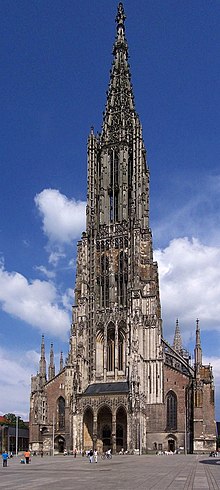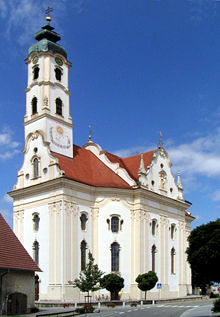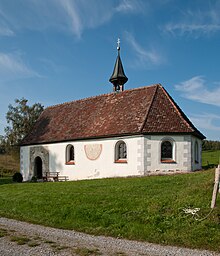Upper Swabian Way of St. James
| Upper Swabian Way of St. James | |
|---|---|
 Upper Swabian Way of St. James Temple Ulm |
|
| Data | |
| length | 159 km |
| location |
|
| Starting point |
Münsterplatz , Ulm 48 ° 23 ′ 54.5 ″ N , 9 ° 59 ′ 28.6 ″ E |
| Target point |
Münster , Constance with connection to Schwabenweg Switzerland 47 ° 39 ′ 48 ″ N , 9 ° 10 ′ 34 ″ E |
| Type | Pilgrimage |
| Height difference | approx. 200 m |
| The highest point | 606 m above sea level NN (Bergatreute) |
| Lowest point | Lake Constance shore 405 m above sea level NN |
| Level of difficulty | hilly pre-alpine landscape without any particular gradients |
| Viewpoints | Ulm from the views of the Austrian and Swiss is Alps possible |
| particularities | medieval, free imperial cities and monasteries, well preserved |
The Upper Swabian Way of St. James is a section of the Way of St. James in Baden-Württemberg . The section of this long-distance hiking trail leads as a pilgrimage route over a total of 159 kilometers from the Münsterplatz in Ulm on the Danube to the Konstanzer Münster on Lake Constance and crosses western Upper Swabia . Lake Constance between Meersburg and Konstanz was crossed by ship or is today crossed by the Meersburg − Konstanz car ferry, which runs regularly . The path is continued in Switzerland as the Schwabenweg .
Early history
According to a legend, Saint Jacob appeared in a dream to the king of the Franconian Empire and later Emperor Charlemagne . This commanded him a campaign to free Gothiens from the Moors . Karl carried out the campaign and established the Spanish mark on the south-western border of his empire . This legend is represented with three other legends on the Karlsschrein in Aachen . Emperor Karl stayed in Ulm several times. According to tradition, a chapel dedicated to Saint Jacob was built in Ulm in 1181, but it was removed in 1538. In the cathedral there are depictions of Jacob from the 16th century.
The Dominican , pilgrim and travel writer Felix Fabri lived for a long time in the 15th century in the monastery of the Dominican Sisters of Ulm. In Evagatorium and in Sionspilgerin he described his spiritual and real journeys to the Holy Land, to Rome and to Santiago de Compostela , in some cases individual stages from Ulm to Lake Constance.
Ulrich von Winterstetten , also called Schenk Ulrich von Schmalegg, probably died in Winterstettenstadt . The Upper Swabian Way of St. James passes this place on the third stage from Steinhausen to Bad Waldsee.
History - Additions - Course
Modern rediscovery, furnishings and signage
At the suggestion of the Council of Europe, the Meckenbeuren state seminar for practical school training and the St. Jakobus Society set up the route from Bad Waldsee to Meersburg in the summer of 1996, partly on already existing Albverein routes with a connection to the Schwabenweg , which is marked from Konstanz and runs through eastern Switzerland to Einsiedeln Monastery leads. Previously, Wolfgang Lipp had evaluated many sources in a long process of viewing and collecting that historically substantiated the route. In the practical implementation of the path, the two findings prevailed that one “must not stick to one concept of so-called historical pilgrimage routes ”, but that one must also “connect points that generally document the cult of St. James”. On the other hand, the Way of St. James is not always the main road. “Apparently not all pilgrims have walked the great street; especially at the end of the 15th century they were not always welcomed by carters, merchants and escorts. They avoided untrodden paths ”.
In 1997 the gap from Ulm to Bad Waldsee was closed, partly on paved roads, but partly also on field and forest paths. In any case, the idea of the old pilgrimage on foot had also taken shape in southern Germany. The path from Ulm is marked with the yellow shell on a blue background, blue and yellow are the colors of Europe . Shell and walking sticks are the signs of the pilgrims to St. James. There are signs at many turns, followed by stickers and small walking boards.
Along the way, pilgrims can get stamps for the pilgrim ID in various churches .
Feedings from the north
Two signposted routes lead to Ulm from the north, which unite at the Ulm Minster: the eastern route, the Franconian Way of St. James , from Nuremberg via Neresheim , Giengen an der Brenz and Oberelchingen . The more westerly route from Würzburg or Rothenburg ob der Tauber via Böhmenkirch , Lonsee to Ulm is known as the Franconian-Swabian Way of St. James .
At Lake Constance, shortly before Constance, the Via Beuronensis comes from the Neckar area and then leads from the Constance Minster as the Schwabenweg into Switzerland.
Historical routes and waterways
In the Middle Ages, from 1181, long before the cathedral, there was a Jakobuskapelle in Ulm as a central meeting point for pilgrims from the north. This chapel on the leather market was already gone at the end of the Reformation. In the cathedral itself there were four altars before the iconoclasm , at which James the Elder was visible as a copatron . A pilgrims' hostel existed near the town hall (today by the museum).
The Upper Swabian Way of St. James is based on the old military roads of the Romans and the historical trade routes of merchants. Overall, the path moves through a landscape that is characterized by Baroque buildings. The path follows the course of the Danube in sections, then the Riss and the Schussen ; Finally, the path near Meersburg approaches the Untersee of Lake Constance. Between Steinhausen and Bad Waldsee, the path follows the Black Forest-Swabian-Alb-Allgäu-Weg , the so-called HW 5 , which was created and is managed by the Swabian Alb Association .
The path stretches from the slopes of the Swabian Alb in Ulm on the Danube in stages through Upper Swabia to the shores of Lake Constance in Meersburg. The route also passes a piece of the listed Reichsstraße before Erbach , on the 1770 Maria Antonia Archduchess of Austria, later named Marie Antoinette from Vienna to Paris for her wedding to the French King Louis XVI. traveled .
The route is partly identical to the Upper Swabian Baroque Road , the Upper Swabian Pilgrim's Path , the Upper Swabian part of the Southern Railway , the Swabian Baths Road , the German Half-timbered Road and the Jubilee Trail around Lake Constance .
Overview
| From | To | Distance in km | Places and sights |
|---|---|---|---|
| Ulm | Oberdischingen | 21st | Ulm Minster , Weinhof with New Synagogue , Martin Luther Church (Ulm) , Kuhberg, former concentration camp “Oberer Kuhberg” , Jakobuskirche Grimmelfingen, Einsingen, Höfe von Wernau, Jakobsfresken in the parish church St. Martinus von Erbach, Donaurieden, Cursillohaus in Oberdischingen |
| Oberdischingen | Apples | 23 | Oberdischingen, Ersingen, Donausüdstraße , Fort Rißtissen , Riißissen with the castle of the von Stauffenberg family , Niederkirch, Untersulmetingen , Obersulmetingen , Öschhof, Schemmerberg , Äpfingen |
| Apples | Steinhausen | 23 | Äpfingen, Laupertshausen , Mettenberg, Simultaneum St. Martin Biberach and the historical Biberach hospice, old town of Biberach an der Riss , Wolfentalmühle, Reute, Bartholomäuskapelle in Grodt , Muttensweiler, Steinhausen |
| Steinhausen | Bad Waldsee | 27 | Pilgrimage church Steinhausen with Jakobus im Stuck, Winterstettenstadt , Bad Waldsee |
| Bad Waldsee | Ravensburg | 26th | Bad Waldsee, Gut-Betha-Platz, Frauenberg chapel on the Frauenberg of Bad Waldsee, Arisheim, Dinnenried, St. George's Chapel in Gwigg , Church of St. Philippus and Jakobus in Bergatreute (as a detour), Gambach, Engenreute, Köpfingen, Weingarten Abbey and Basilica St. Martin , holy blood relic , through the Frauentor to Ravensburg with numerous historical churches, monasteries and pilgrimage hostels, protective mantle Madonna |
| Ravensburg | Brochenzell | 14.5 | Ravensburg, Mühlbruck chapel at the bridge over the Schussen , Weststadt, Weißenauer Forst, Brochenzell |
| Western route from Brochenzell | |||
| Brochenzell | Markdorf | 14.5 | Brochenzell, Furatweiler, Zillisbach, Krehenberg, Oberteuringen- Blankenried, Rammertshofen, Unterteuringen , Hepbach , Leimbach , Möggenweiler , Markdorf with numerous historical chapels, the Prince-Bishop's Castle in Markdorf |
| Markdorf | Meersburg or Konstanz |
11 or 15 |
Markdorf, Braitenbach, summer residence of the prince-bishops of Constance, Annette-von-Droste-Hülshoff museum and New Castle (Meersburg) , bank promenade and car ferry Constance – Meersburg with Lake Constance, Staad, Petershausen, Constance; there at the cathedral with its Mauritius rotunda , which is important for pilgrims , the Schwabenweg begins , another 2,340 kilometers ... |
| Eastern route from Brochenzell | |||
| Brochenzell | Nun's horn | 23 | Tettnang , Giessen Bridge , Giessen Castle , Heiligenhof , Atlashofen , Hüttmannsberg , Gattnau , Arensweiler , Selmnau , Nonnenhorn ; from here east around Lake Constance to Bregenz . At Lindau , this section joins the Bavarian-Swabian Jakobusweg , crosses the Austrian border, leads along the Vorarlberg shores of Lake Constance past the Abbey of Mehrerau Abbey into Switzerland ; from there on via St. Gallen and Rapperswil-Jona also to Einsiedeln Abbey. |
Stamp offices
Pilgrim stamps for the pilgrim ID card are available in Ulm at the gate of the minster and in the Grimmelfingen district in the vestibule of the Protestant Jakobus Church, in Erbach in the St. Martinus church, in Oberdischingen in the foyer of the Cursillo House St. Jakobus.
Antiphons
In the 15th century, Felix Fabri not only described the stages, but also the rites and chants of the pilgrims on the Camino de Santiago. The antiphons that the pilgrims sang on their spiritual pilgrimage to Santiago were "O beate Jacobe" and "Ecce ego mitto".
Stations along the route
Painted scallop shell on a blue background near Oberdischingen.
Yellow box near Markdorf, in which a pilgrim stamp for pilgrims is kept.
See also
literature
Hiking guide
- Gerhild Fleischer: Jakobsweg II - From Ulm to Bad Waldsee . Schwabenverlag, Ostfildern 1997, 6th revised edition 2011, ISBN 3-7966-0905-8 .
- Gerhild Fleischer: Jakobsweg III - From Bad Waldsee to Constance . Schwabenverlag, Ostfildern 1997 (2nd edition). ISBN 3-7966-0798-5 .
- Klaus Herbers : Way of St. James. History and culture of a pilgrimage . Beck, Munich 2006, ISBN 3-406-53594-1
- Wolfgang W. Meyer: Jakobswege / Württemberg-Baden-Franconia-Switzerland . 1st edition. Silberburg-Verlag, Tübingen 2000, ISBN 3-87407-342-4 .
- Wolfgang Lipp : The way to Santiago - Way of St. James in southern Germany . Ulm 1991, ISBN 3-88294-164-2
- Bert Teklenborg: On the Way of St. James. From southern Germany through Switzerland to Le Puy and Arles in France. Hiking guide - route planner . Publishing House Tyrolia, Innsbruck 2004, ISBN 3-7022-2627-3 .
Hiking maps
- Hiking maps of the State Office for Geoinformation and Rural Development Baden-Württemberg and the Swabian Alb Association , scale 1: 35,000, Stuttgart; the course of the Upper Swabian Way of St. James is shown in more recent editions.
Web links
- German St. James Society V.
- Oberschwaben Tourismus GmbH
- Cursillohaus Oberdischingen, the spiritual center of the Roman Catholic Church on the Upper Swabian Way of St. James
- Upper Swabian Way of St. James on Way of St. James WIKI
Individual evidence
- ↑ Gerhilde Fleischer: Jakobusweg II . 4th edition. Ostfildern 2006, p. 7
- ↑ Wolfgang Lipp: The way to Santiago . Ulm 1991
- ↑ Klaus Herbers, in his foreword to Gerhilde Fleischer: Jakobusweg III . 6th edition. Ostfildern 2006, p. 7
- ↑ Wolfgang Lipp: The way to Santiago . Ulm 1991, p. 24
- ↑ so Klaus Herbers in his foreword to Gerhilde Fleischer: Jakobusweg III . 6th edition. Ostfildern 2006, p. 7
- ↑ Gerhilde Fleischer, Jakobsweg I, Ostfildern 1997
- ↑ Wolfgang W. Meyer, Jakobswege, Tübingen 2006, 5th edition, p. 7 and pp. 189–227
- ↑ Gerhilde Fleischer: Jakobusweg II . 4th edition. Ostfildern 2006, p. 11
- ↑ Wolfgang W. Meyer: Way of St. James . Tübingen 2006, 5th edition, p. 190
- ^ Wolfgang Lipp: The way to Santiago - Way of St. James in southern Germany . Ulm 1991, p. 100
← Previous location: Ulm Minster | Upper Swabian Way of St. James | Next place: Constance Minster →












